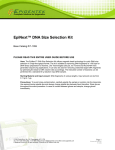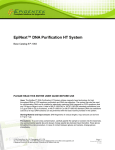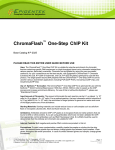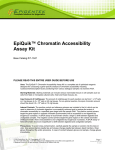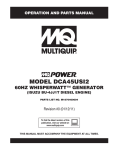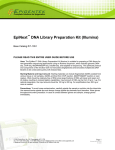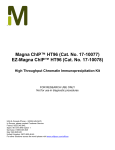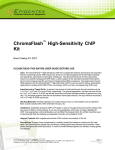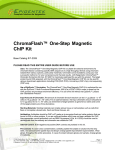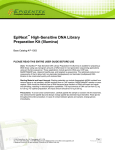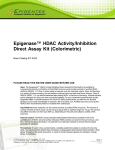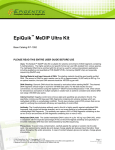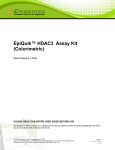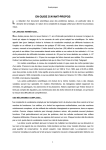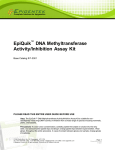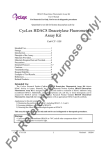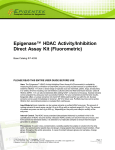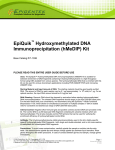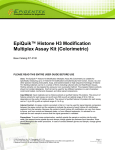Download Pre-Sure™ ChIP Antibody Validation Kit
Transcript
EPIGENTEK Complete Solutions for Epigenetics Pre-Sure™ ChIP Antibody Validation Kit Base Catalog # P-2031 PLEASE READ THIS ENTIRE USER GUIDE BEFORE USE Uses: The Pre-Sure™ ChIP Antibody Validation Kit is used for determining if antibodies are qualified for chromatin immunoprecipitation (ChIP) using chromatin isolated from various species, particularly mammals, in a high throughput format. Chromatin can be isolated and sheared using your own successful method or commercially available kit. For your convenience and the best results, Epigentek’s ChromaFlash™ Chromatin Isolation & Shearing Kit (Cat. # P-2023) is optimized for use with this product. Input Amount of Chromatin: The amount of chromatin for each reaction can be 0.2 µg (about 2 x 104 cells) to 5 µg (about 0.5 x 106 cells) depending on whether the antibody-targeting proteins are highly abundant or not. For an optimal reaction, the input chromatin amount should be 1 µg (about 1 x 105 cells) since enrichment of target proteins to genome loci varies and some target proteins are of low abundance. Starting Materials: Starting materials can include various tissue or cell samples such as cultured cells from a flask or dish. Antibodies: The antibodies to be tested can be monoclonal and polyclonal antibodies generated from any species and should be IgG type. For the best results, the specificity of the antibodies should be pre-tested by ELISA or Western blot. Internal Controls: The assay standard, negative non-immune IgG control, and positive antibody control are provided in this kit. The assay standard is used to determine ChIP enrichment efficiency and the negative and positive controls can be used for determining the specificity of the validation test and if the test was successfully performed. Precautions: To avoid cross-contamination, carefully pipette the sample or solution into the strip wells. Use aerosol-barrier pipette tips and always change pipette tips between liquid transfers. Wear gloves throughout the entire procedure. In case of contact between gloves and sample, change gloves immediately. 110 Bi County Blvd. Ste. 122, Farmingdale, NY 11735 Tel: 1-877-374-4368 ■ Fax: 1-718-484-3956 ■ E-mail: [email protected] ■ Web: www.epigentek.com © Epigentek Group Inc. All rights reserved. Products are for research use only. Page 1 Printed 2014-07-02 P-2031 EPIGENTEK Complete Solutions for Epigenetics KIT CONTENTS Components WB1 (10X Wash Buffer 1) WB2 (Wash Buffer 2) AB (Antibody Buffer) CB (ChIP Buffer) Positive Control (Core Chromatin, 400 µg/ml) Non-Immune IgG (1 mg/ml)* AcH3 Antibody (0.6 mg/ml)* Fluoro Assay Solution (100 X)* 8-Well Assay Strips (With 1 Frame) Adhesive Covering Film User Guide 48 assays P-2031-48 96 assays P-2031-96 Storage Upon Receipt 15 ml 15 ml 6 ml 15 ml 20 µl 10 µl 5 µl 60 µl 6 1 1 30 ml 30 ml 12 ml 30 ml 40 µl 20 µl 10 µl 120 µl 12 2 1 4°C RT RT RT -20°C 4°C 4°C -20°C 4°C RT RT * Spin the solution down to the bottom before use. SHIPPING & STORAGE The kit is shipped in two parts: the first part at ambient room temperature and the second part on frozen ice packs at 4°C. Upon receipt: (1) Store Positive Control and Fluoro Assay Solution at -20°C. (2) Store WB1, NonImmune IgG, AcH3 Antibody and 8-Well Assay Strips (With 1 Frame) at 4°C away from light; (3) Store remaining components at room temperature away from light. All components of the kit are stable for 6 months from the date of shipment, when stored properly. Note: Check if WB1 contains salt precipitates before use. If so, briefly warm at room temperature or 37°C and shake the buffer until the salts are re-dissolved. MATERIALS REQUIRED BUT NOT SUPPLIED Incubator oven with variable temperature Adjustable pipette and multiple-channel pipette Aerosol resistant pipette tips Antibodies of interest Chromatin extracts Orbital shaker 110 Bi County Blvd. Ste. 122, Farmingdale, NY 11735 Tel: 1-877-374-4368 ■ Fax: 1-718-484-3956 ■ E-mail: [email protected] ■ Web: www.epigentek.com © Epigentek Group Inc. All rights reserved. Products are for research use only. Page 2 Printed 2014-07-02 P-2031 EPIGENTEK Complete Solutions for Epigenetics Fluorometer/Fluorescence microplate reader Solution reservoirs GENERAL PRODUCT INFORMATION Quality Control: Each lot of the Pre-Sure™ ChIP Antibody Validation Kit is tested against predetermined specifications to ensure consistent product quality. Epigentek guarantees the performance of all products in the manner described in our product instructions. Product Warranty: If this product does not meet your expectations, simply contact our technical support unit or your regional distributor. We also encourage you to contact us if you have any suggestions about product performance or new applications and techniques. Safety: Suitable lab coat, disposable gloves, and proper eye protection are required when working with this product. Product Updates: Epigentek reserves the right to change or modify any product to enhance its performance and design. The information in this User Guide is subject to change at any time without notice. Thus, only use the User Guide that was supplied with the kit when using that kit. Usage Limitation: The Pre-Sure™ ChIP Antibody Validation Kit is for research use only and is not intended for diagnostic or therapeutic application. Intellectual Property: The Pre-Sure™ ChIP Antibody Validation Kit and methods of use contain proprietary technologies by Epigentek. A BRIEF OVERVIEW The interactions between protein and DNA plays a critical role for cellular functions such as signal transduction, gene transcription, chromosome segregation, DNA replication and recombination, and epigenetic silencing. Identifying the genetic targets of DNA binding proteins and knowing the mechanisms of protein-DNA interactions is important for understanding cellular process. Chromatin immunoprecipitation (ChIP) offers an advantageous tool for studying protein-DNA interactions. It detects that a target protein binds to specific sequences of a gene in living cells by PCR (ChIP-PCR), microarrays (ChIP-chip), or sequencing (ChIP-seq). In particular, ChIP that uses antibodies directly against various transcription factors (TF) for genome-wide transcription factor binding site analysis by next generation sequencing is in high demand. Reliable enrichment of target protein/DNA complexes is critical for deriving high-quality data from ChIP-based PCR, microarray and sequencing. More importantly, the qualified ChIP antibody determines the success or failure of a ChIP. There are many antibodies against the same protein/antigen target available today. The affinity and specificity of these antibodies are generally determined using complementary methods such as Western blot, immunofluorescence, peptide arrays, and peptide competition assays. However, most of these antibodies are not validated for their ability to enrich target protein/DNA complexes contained in chromatin. Furthermore, some antibodies labeled as “ChIP-validated” available on the market may not be internally tested. Even if the published data shows that it is a “ChIP-validated” antibody, the same results may not always be reproduced due to Lot-to-Lot variation of the antibody. 110 Bi County Blvd. Ste. 122, Farmingdale, NY 11735 Tel: 1-877-374-4368 ■ Fax: 1-718-484-3956 ■ E-mail: [email protected] ■ Web: www.epigentek.com © Epigentek Group Inc. All rights reserved. Products are for research use only. Page 3 Printed 2014-07-02 P-2031 EPIGENTEK Complete Solutions for Epigenetics Currently there are no assays or tests available to quickly check if the target protein/DNA complex was successfully enriched by the antibody unless a downstream application such as PCR, microarray or sequencing is performed. Routinely validating if the target protein/DNA complex is successfully enriched by the antibody before downstream application would ensure the success of a ChIP and allow time saving labor reduction and cost effectiveness. As the leading provider of various ChIP kits and epigenetic antibodies, Epigentek utilized its expertise to develop the Pre-Sure™ ChIP Antibody Validation Kit, the first commercially available product for fast validation of ChIP-grade antibodies. The Pre-Sure™ ChIP Antibody Validation Kit has the following advantages: High Speed - The entire procedure can be completed in less than 3 hours with the actual handling time being less than 30 minutes. High Specificity - Detected signals are specifically from the target protein-DNA complex captured by the antibody and fully consistent with results obtained by ChIP-qPCR. High Efficiency - Direct quantification of target protein/DNA complexes captured by the antibody. No need for PCR amplification and sequencing. High Sensitivity - As low as 0.5 ng of the enriched target protein-DNA complex can be detected. High Throughput - 96 strip-well plate format allow for validation of a single antibody each time or up to 43 antibodies simultaneously. High Convenience - An assay control (core chromatin), negative control non-immune IgG, and positive control antibody are provided in the kit, and are used for determination of ChIP enrichment efficiency, specificity of the validation test, whether test was successfully performed overall. PRINCIPLE & PROCEDURE The Pre-Sure™ ChIP Antibody Validation Kit contains all necessary reagents required for carrying out a successful ChIP antibody validation test using sheared chromatin from mammalian cells or tissue. This kit includes a positive control antibody, a negative control non-immune IgG, and core chromatin extract that can be used as a positive control to demonstrate the efficacy of the kit reagents and protocol. The antibodies are first bound to the assay wells. The positive control antibody AcH3 is ChIPgrade, which can immunoprecipitate the acetylated histone H3 complexed with DNA in core chromatin and generate a fluorescent signal in the reaction with the Fluoro Assay Solution. Similarly, if the tested antibody works in ChIP, it can also capture target protein-DNA complex from chromatin and generate a fluorescent signal. The signal intensity is proportional to the amount of protein-DNA complexes captured by the antibody, and accordingly indicates if the antibody is ChIP-grade and the grade intensity. 110 Bi County Blvd. Ste. 122, Farmingdale, NY 11735 Tel: 1-877-374-4368 ■ Fax: 1-718-484-3956 ■ E-mail: [email protected] ■ Web: www.epigentek.com © Epigentek Group Inc. All rights reserved. Products are for research use only. Page 4 Printed 2014-07-02 P-2031 EPIGENTEK Complete Solutions for Epigenetics 500 7 qPCR-GAPDH Amplification (fold) 450 400 R2 = 0.9366 350 300 250 200 6 150 5 100 4 50 1 0 0 3 2 5 10 15 20 25 ChIP-Grade Intensity (fold) Fig. 2. ChIP-grade Antibody Validation: Core chromatin isolated from Fig. 1. Schematic procedure of the Pre-Sure TM ChIP Antibody Validation Kit Hela cells was used for measuring ChIP-Grade Intensity (CGI) of each antibody using the Pre-Sure™ ChIP Antibody Validation Kit. To confirm the CGI results, ChIP-qPCR analysis was performed using the same antibodies to enrich the protein or modified histone-DNA complexes on euchromatin. A euchromatic GAPDH locus served as a reference. The antibodies H3K4m2 (3), H3K9ac (4), Dnmt1 (5), H3K18ac (6), and H3K14ac (7), which are demonstrated to be ChIP-grade by epigenetics researchers, highly enriched the proteins/modified his tones associated with euchromatin, while antibodies HDAC4 (1) and H3K9m2 (2) which are less associated with euchromatin, show no/little enrichment. ASSAY PROTOCOL For the best results, please read the protocol in its entirety prior to starting your experiment. Starting Materials Input Chromatin Amount: Chromatin amount can range from 0.2 µg to 5 µg per reaction. An optimal amount is 1 µg per reaction. Chromatin isolation/shearing: You can use your method of choice for chromatin isolation and shearing. Epigentek offers the ChromaFlash™ Chromatin Isolation/Shearing Kit (Cat. # P-2023) for your convenience. Chromatin can be isolated from various tissue and cells. For the best results, the chromatin should be isolated from cultured cell lines grown in log phase. For histone-targeting 110 Bi County Blvd. Ste. 122, Farmingdale, NY 11735 Tel: 1-877-374-4368 ■ Fax: 1-718-484-3956 ■ E-mail: [email protected] ■ Web: www.epigentek.com © Epigentek Group Inc. All rights reserved. Products are for research use only. Page 5 Printed 2014-07-02 P-2031 EPIGENTEK Complete Solutions for Epigenetics antibodies, the tissue/cell cross-linking is not required. However for non-histone targeting antibodies such as those for transcription factors, the tissue/cells should be cross-linked before chromatin isolation. The chromatin can be sheared by water-bath based sonication or probe-based sonication according to the supplier’s instructions. The sheared DNA/chromatin size should be between 150-1000 bps. Chromatin Storage: Isolated chromatin can be stored at -20°C (short term), or -80°C (long term) until use. 1. Prepare Diluted WB1 (1X Wash Buffer) 48-Assay Kit: Add 13 ml of WB1 10X Wash Buffer to 117 ml of distilled water. 96-Assay Kit: Add 26 ml of WB1 10X Wash Buffer to 234 ml of distilled water. This Diluted WB1 1X Wash Buffer can now be stored at 4°C for up to six months. 2. Antibody Binding to Strip Wells a. Predetermine the number of strip wells required for your experiment. Carefully remove un-needed strip wells from the plate frame and place them back in the bag (seal the bag tightly and store at 4°C). b. Setup the antibody binding reactions by adding the reagents to each well according to the following chart: Reagents AB Antibody Buffer Your Antibodies AcH3 Antibody Non-Immune IgG Samples Positive Controls (1 and 2)* Negative Controls (1 and 2)* Blank 100 µl 100 µl 100 µl 100 µl 0.5-2 µl 0 0 0 0 0.6 µl 0 0 0 0 0.6 µl 0 Note: The final amount of each component should be (a) antibodies of interest: 0.6 µg/well; (b) AcH3 antibody: 0.6 µg/well; and (c) non-immune IgG: 0.6 µg/well. The final volume in each assay well can range from 100.5 µl to 102 µl. This slight variation in volume for each well will not affect the assay performance. The volume in each assay well should not exceed 102 µl. *Two positive and two negative controls should be set up for the assay. One positive and one negative control for the input chromatin sample and one positive and one negative control for the provided Positive Control (Core Chromatin) and Non-Immune IgG, respectively. c. Seal the wells with Adhesive Covering Film strips and incubate the wells at room temperature for 60 min. 3. Preparation of ChIP Reaction a. Carefully peel away the Adhesive Covering Film on the antibody binding wells (from Step 2) to avoid contamination between each well. 110 Bi County Blvd. Ste. 122, Farmingdale, NY 11735 Tel: 1-877-374-4368 ■ Fax: 1-718-484-3956 ■ E-mail: [email protected] ■ Web: www.epigentek.com © Epigentek Group Inc. All rights reserved. Products are for research use only. Page 6 Printed 2014-07-02 P-2031 EPIGENTEK Complete Solutions for Epigenetics b. Using a pipette, remove the antibody reaction solution and Non-immune IgG solution from each well and wash the wells one time with 150 µl of CB (ChIP Buffer). To wash the wells, pipette CB (ChIP Buffer) into the wells then remove it from the wells and discard it. c. Setup the ChIP reactions by adding the reagents to the wells that are bound with antibodies (sample and positive control wells) or IgG (negative control well) according to the following chart: Reagents Sample Blank Positive Control 1 Positive Control 2 Negative Control 1 Negative Control 2 CB (ChIP Buffer) 90-98 µl 100 µl 90-98 µl 97.5 µl 90-98 µl 97.5 µl Chromatin 2-10 µl 0 2-10 µl 0 2-10 µl 0 0 0 0 2.5 µl 0 2.5 µl Positive Core Chromatin Note: The final amount of chromatin should be 1 µg/well (1 X 105 cells may yield 1 µg of chromatin); Sonicated chromatin can be further diluted with CB (ChIP Buffer) to desired concentration. Freshly prepared chromatin can be directly used for the reaction. Frozen chromatin samples should be thawed quickly at RT and then placed on ice before use. Store remaining chromatin samples at -20°C, or at -80°C if they will be not used within 8 hours. d. Cap wells with Adhesive Covering Film strips and incubate at room temperature for 90 min on an orbital shaker (100 rpm). For low abundance targets, the incubation time should be extended to 2-3 hours. 4. Washing of the Reaction Wells a. Carefully remove the solution from each well and discard it. b. Wash each well four times with 200 µl of Diluted WB1 each time. To wash the wells, pipette Diluted WB1 into the wells then remove it from the wells and discard it. Repeat four a total of four washes. c. Wash each well one time with 200 µl of WB2. To wash the wells, pipette WB2 into the wells and then remove it from the wells and discard it. 5. Signal Detection and Calculation a. Prepare the 1X Fluoro Assay Solution by adding 1 µl of 100X Fluoro Assay Solution into 99 µl of WB2. b. Add 100 µl of 1X Fluoro Assay Solution into each well and incubate at room temperature for 1-3 minutes away from light. Measure and read fluorescence on a fluorescence microplate reader at 490EX/530EM nm. The signal is stable for about 2 hours. c. Calculate ChIP-grade intensity of antibody using the following formula: Antibody RFU – Blank RFU ChIP-Grade Intensity (CGI) = IgG RFU – Blank RFU 110 Bi County Blvd. Ste. 122, Farmingdale, NY 11735 Tel: 1-877-374-4368 ■ Fax: 1-718-484-3956 ■ E-mail: [email protected] ■ Web: www.epigentek.com © Epigentek Group Inc. All rights reserved. Products are for research use only. Page 7 Printed 2014-07-02 P-2031 EPIGENTEK Complete Solutions for Epigenetics In general, an antibody is considered ChIP-grade if the CGI is > 4. A greater CGI indicates an antibody which is more robust for ChIP. Antibodies that are validated using this assay can be further confirmed by performing a proper ChIP-qPCR test. SUGGESTED STRIP WELL SETUP The suggested strip-well plate setup in a 48-assay format (for a 96-assay format, Strips 7 to 12 can be configured as Sample). The controls and samples can be measured in duplicate. Well # A B C D E F G H Strip 1 Blank Negative Control 1 Negative Control 2 Positive Control 1 Positive Control 2 Sample Sample Sample Strip 2 Blank Negative Control 1 Negative Control 2 Positive Control 1 Positive Control 2 Sample Sample Sample Strip 3 Sample Sample Sample Sample Sample Sample Sample Sample Strip 4 Sample Sample Sample Sample Sample Sample Sample Sample Strip 5 Sample Sample Sample Sample Sample Sample Sample Sample Strip 6 Sample Sample Sample Sample Sample Sample Sample Sample TROUBLESHOOTING Problem Possible Cause Suggestion Little or No Signal from both Sample and Positive Control 1 Wells Poor chromatin quality due to insufficient amount of cells or insufficient or over cross-linking. The optimal amount of chromatin per ChIP reaction is 0.2-5 µg which may be 6 obtained from 0.5-1x10 cells, respectively. The minimal amount of chromatin that should be used is 0.2 µg which may be obtained from 20,000 cells. Appropriate chromatin cross-linking is also required. Insufficient or overcrosslinking will cause dissociation of the target protein from DNA or less antibody binding. During the crosslinking step of chromatin preparation, ensure that the cross-linking time is from 10-15 min, the final concentration of formaldehyde is 1%, and/or the quench solution is 0.125 M glycine. Improper antibody binding or ChIP reaction conditions with antibody. Check if the antibody binding and ChIP reaction conditions and steps are correct. Inappropriate chromatin shearing conditions. If chromatin is from specific cell/tissue types, or is differently fixed, the shearing conditions should be optimized to allow the DNA fragment size to be between 250-1000 bps. 110 Bi County Blvd. Ste. 122, Farmingdale, NY 11735 Tel: 1-877-374-4368 ■ Fax: 1-718-484-3956 ■ E-mail: [email protected] ■ Web: www.epigentek.com © Epigentek Group Inc. All rights reserved. Products are for research use only. Page 8 Printed 2014-07-02 P-2031 EPIGENTEK Complete Solutions for Epigenetics Little or No Signal from Sample, Positive Control 1 and Positive Control 2 Wells Incorrect temperature and/or insufficient time during antibody binding and ChIP reaction. Ensure the incubation times and temperatures described in the protocol are followed correctly. Improper measurement of signals. Ensure the proper wavelength (490EX/530EM nm) is set. Improper sample or kit storage. Chromatin sample should be stored at -80°C for no longer than 6 months, preferably less than 3 months. Avoid repeated freeze/thaw cycles. Each component of the kit should be stored according to the user guide No Difference in Signal Intensity Between Negative and Positive Control Wells Insufficient washing. Check if washing recommendations at each step is performed according to the protocol. If the signal intensity in the negative control is still high, washing stringency can be increased in the following ways: 1. Increase wash time at each wash step: after adding Diluted WB1, leave it in the wells for 2-3 min and then remove it. 2. Add an additional one to two washes: The provided volume of WB1 is sufficient for 4 extra washes for each sample. Little or No Signals Generated From Each Sample Well Only Insufficient amount of the antibodies added into the reaction. Check if the amount of antibody added into the reaction is sufficient (0.6 µg/well) and if not, increase the amount of antibody. RELATED PRODUCTS ChIP Reaction P-2002 P-2003 P-2014 P-2025 P-2026 EpiQuik™ Chromatin Immunoprecipitation (ChIP) Kit EpiQuik™ Tissue Chromatin Immunoprecipitation (ChIP) Kit EpiQuik™ Plant ChIP Kit ChromaFlash™ One-Step ChIP Kit ChromaFlash™ One-Step Magnetic ChIP Kit Chromatin Preparation P-2001 ChromaFlash™ Chromatin Extraction Kit P-2023 ChromaFlash™ Chromatin Isolation & Shearing Kit Sonication Instruments EQC-1100 EpiSonic™ Multi-Functional Bioprocessor 1100 PCR Analysis P-1029 EpiQuik™ Quantitative PCR Fast Kit 110 Bi County Blvd. Ste. 122, Farmingdale, NY 11735 Tel: 1-877-374-4368 ■ Fax: 1-718-484-3956 ■ E-mail: [email protected] ■ Web: www.epigentek.com © Epigentek Group Inc. All rights reserved. Products are for research use only. Page 9 Printed 2014-07-02 P-2031









